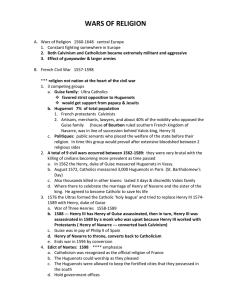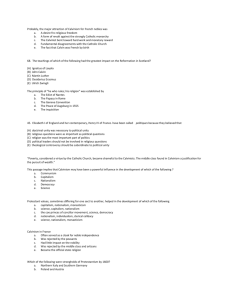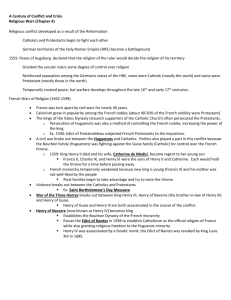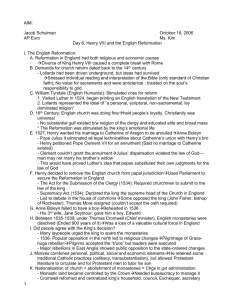Era of Religious Wars
advertisement
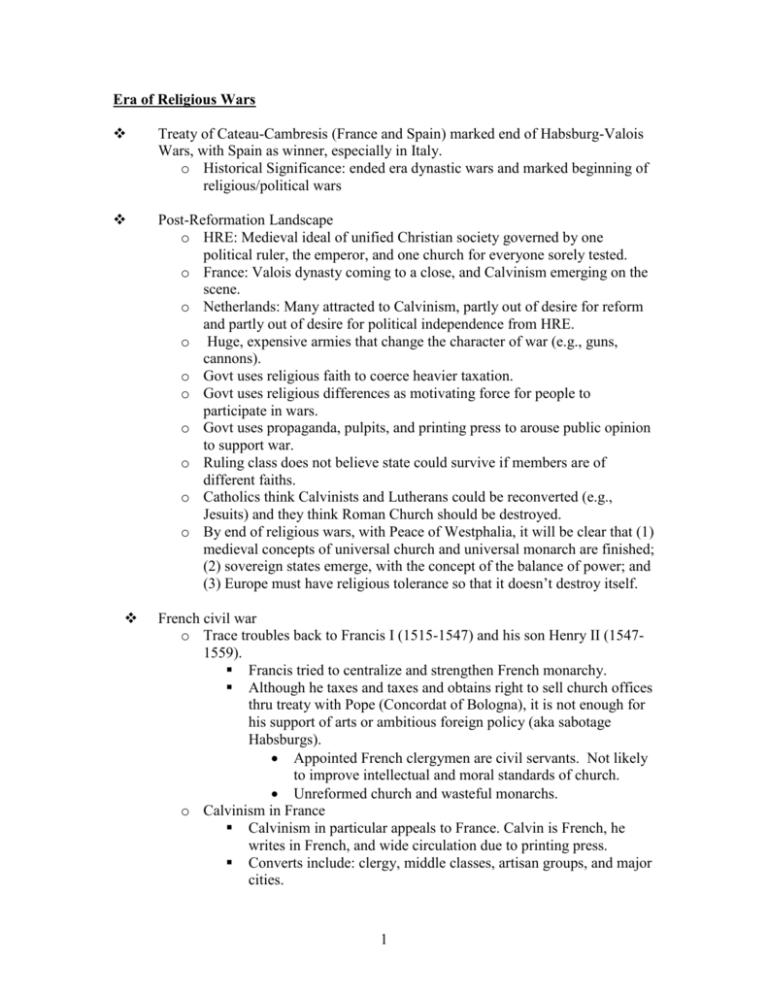
Era of Religious Wars Treaty of Cateau-Cambresis (France and Spain) marked end of Habsburg-Valois Wars, with Spain as winner, especially in Italy. o Historical Significance: ended era dynastic wars and marked beginning of religious/political wars Post-Reformation Landscape o HRE: Medieval ideal of unified Christian society governed by one political ruler, the emperor, and one church for everyone sorely tested. o France: Valois dynasty coming to a close, and Calvinism emerging on the scene. o Netherlands: Many attracted to Calvinism, partly out of desire for reform and partly out of desire for political independence from HRE. o Huge, expensive armies that change the character of war (e.g., guns, cannons). o Govt uses religious faith to coerce heavier taxation. o Govt uses religious differences as motivating force for people to participate in wars. o Govt uses propaganda, pulpits, and printing press to arouse public opinion to support war. o Ruling class does not believe state could survive if members are of different faiths. o Catholics think Calvinists and Lutherans could be reconverted (e.g., Jesuits) and they think Roman Church should be destroyed. o By end of religious wars, with Peace of Westphalia, it will be clear that (1) medieval concepts of universal church and universal monarch are finished; (2) sovereign states emerge, with the concept of the balance of power; and (3) Europe must have religious tolerance so that it doesn’t destroy itself. French civil war o Trace troubles back to Francis I (1515-1547) and his son Henry II (15471559). Francis tried to centralize and strengthen French monarchy. Although he taxes and taxes and obtains right to sell church offices thru treaty with Pope (Concordat of Bologna), it is not enough for his support of arts or ambitious foreign policy (aka sabotage Habsburgs). Appointed French clergymen are civil servants. Not likely to improve intellectual and moral standards of church. Unreformed church and wasteful monarchs. o Calvinism in France Calvinism in particular appeals to France. Calvin is French, he writes in French, and wide circulation due to printing press. Converts include: clergy, middle classes, artisan groups, and major cities. 1 Monarchs are pretty repressive: universities condemn, govt bans, and heretics burned at stake. # of Protestants grew. At time of Henry II’s death, 40 well-organized Calvinist churches and 1/10 of population. For nobles, more. Up to ½ of the nobles become Calvinist. Why? Assert political independence. o Examples: Bourbon family (e.g., Gaspard de Coligny and Henry of Navarre) o Catholics v. Calvinists Armed clashes between lords of different religions Both believed that the others’ books, services, and ministers polluted the community. Preachers incited violence and ceremonies such as baptisms, marriages, and funerals triggered it. Saint Bartholomew’s Day Massacre King’s sister Margaret of Valois was to marry Protestant Henry of Navarre (Protestant side of Bourbon family), which was intended to help reconcile Catholics and Huguenots Henry of Guise (leader of Catholic aristocracy) tried to have Gaspard de Coligny assassinated (leader of Huguenot party and one of noble Montmorency family) Rioting and slaughter followed. Huguenots gentry in Paris massacred and religious violence spread to provinces. o 12,000 died o Henry of Guise kills Coligny himself o Henry of Navarre given choice to convert to Catholicism or die. o War of Three Henrys Catholic Henry of Guise v. Protestant Henry of Navarre v. Catholic King Henry III o Guise Goals: allied with Catholic nobles (i.e., Holy League) to destroy Calvinism and replace Henry III with member of own family. Backed by Spain and Jesuits Will end up supporting Catholic Cardinal de Bourbon (second in line to throne after Henry of Navarre) o Henry of Navarre He flip-flops back and forth between Calvinism and Catholicism. With no child, he is officially Henry III’s heir. During war, he makes great advances and then relaxes (fight, make love, drink) and loses gains o Henry III (Valois family) Switches alliances during war. With mom Catherine de Medici, he starts with Guise. 2 Finally had Guise assassinated and arrested Cardinal de Bourbon, who then died. 15 years of religious rioting and domestic anarchy. Agriculture destroyed, commercial life declined severely and starvation and death everywhere. Enter politiques. These are moderates of both faiths that believe only restoration of strong monarchy could reverse trend toward collapse of France. After assassinations, Henry of Navarre renounces his Protestantism, becomes Catholic (i.e., Paris is worth a mass), and king Henry IV. o Henry IV Valois family replaced with Bourbon family on French throne. His sacrifice of religious principles to political necessity saved France. Edict of Nantes (1598): affirm Catholicism is official religion, but give Huguenots liberty of conscience and public worship in 150 towns. His goal was a united and strong France Netherlands o Bkgrd Charles V: vast territories from Habsburg inheritance o Inherits Spain + New World, Sardinia, Sicily and Italian holdings from mom o Inherits Austria, Southern Germany, Low Countries, and FrancheComte in France from dad He is pivot around which European money, diplomacy, and war revolved When reformation hits Netherlands, he will react with condemnation and mild repression. But, he was born and raised Flemish, so people loyal to him (i.e., served as check to Lutheranism). Big problem once he abdicates throne at age of 55. o Gives his brother Ferdinand (Austria and HRE) o Gives his son (his Spanish son) Philip II Spain, Low Countries, Milan, Sicily, and American holdings o Netherlands Netherlands are made up of Belgium, Luxembourg and Netherlands of today. They were divided culturally (German, French, and Flemish speaking) and religiously (Catholic, Calvinist, Anabaptist, and Lutheran). 17 provinces. Cities (e.g., Antwerp) grown wealthy from exchange of products from Baltic and Italy, international commerce and finance. They are historically self-governing, make laws and collect own taxes. Only thing connecting them was economic relationship and Charles V as HRE. Southern towns traditionally French, and Northern towns traditionally Dutch. See Lutheran tracts, Dutch Bibles introduced in 1520s and 1530s. 3 o o By 1560s, strong militant minority of Calvinists. Calvinism appealed to middle classes because of its intellectual seriousness, moral gravity, and emphasis of work. Unlike Lutheranism which counseled respect for powers that be, Calvinism encouraged opposition to “illegal” civil authorities. With Philip II in charge, what began as desire of people for church reform ended up as struggle for Dutch independence. Revolt (1566-1587) August 1566: high grain prices, fanatical Calvinists, primarily of poorest classes, embarked on rampage of frightful destruction. Incited by popular preaching Attacks at religious images/structures Sack and burn churches and libraries (NO!!!) Destruction spread to other provinces Philip II’s reaction o Identified religious tolerance with growth of heresy, civil disorder, violence and bloodshed. o Determined to crush heresy in Low Countries. Hired mercenaries using American silver. o Note, however, that Philip is preoccupied. He’s got the Ottoman Empire knocking on his door. o Ultimately sent 20,000 Spanish troops to pacify Low Countries. His man – duke of Alva – ruthless extermination of religious and political dissidents. COUNCIL OF BLOOD. 1500 men executed. Only inflamed situation. 1568-1578: civil war: Catholics vs. Protestants; 17 provinces vs. Spain o 17 provinces will unite under William of Orange (Silent) After his death, South will ultimately remain with Spanish Habsburg. In 1578, duke of Parma crushes revolt using German mercenaries. Avoided pitched battles, fighting by patient sieges. Southern cities fell, including Ghent and Antwerp. Calvinism forbidden: convert or leave. In North, you have 7 provinces led by Holland (i.e., Union of Utrecht). 1581 is Independence. United Provinces. They are mostly commercial aristocracy and are tied up in English affairs (e.g., they are chief market for wool; no English wool exports, no money for English crown). So, they get Elizabeth I to help them after William falls. England worried that Spain would sweep through Netherlands and ultimately invade England (e.g., Philip’s conspiracy with Mary, Queen of Scots, cousin to assassinate Elizabeth, and Pope’s promise to pay Philip 1 million ducats to invade England). o Philip II sends Spanish Armada to England 4 130 ships. Bad weather, supplies, luck. English ships faster, smaller, effective, with greater firing power. England victorious. Only 65 ships make it home. Devastating to Spanish morale, while a positive for England. Significance: prevented Philip from reimposing religious unity on western Europe by force. o 1609: Philip recognizes United Provinces. The borders of 1581 are permanent. Thirty Years War (1618-1648) o “The last of the religious wars” o Since Peace of Augsburg (1555) (i.e., faith of prince = faith of subjects), religion had still played an important divisive role in Germanic states of Holy Roman Empire. o Made peace between Lutherans and Catholics, but no provision for Calvinists. o Luther also gaining more German bishopries. o Jesuits reconverting several princes to Catholicism o Frederick, the Calvinist leader of Palatinate created Protestant Union (1608) of German territories. The Catholics react with own league under Max of Bavaria -- Catholic League (1609). o By 1609, divisions clear and situation heated. o To feed the fire, the Habsburgs were trying to consolidate power over all the territories and were looking at their Spanish branch for help. The opposing princes looked to France for help in retaining some independence. o FOUR RECOGNIZED PHASES OF WAR Bohemian Phase (1618-1625). The princes had accepted Catholic Habsburg Ferdinand as their king but were upset. He closes some Protestant churches and tries to reCatholicize many of the Catholics in the area. In May 1618, some Protestant nobles threw 2 catholic Habsburg nobles out of a window of the royal castle in Prague. The nobles lived and the Catholics used this as evidence of whose side God was on, the Protestants tried to point out that they had fallen into a pile of manure. Frederick of Palatinate, Protestant, becomes leader of Bohemia ousting Ferdinand’s rule. Disaster strikes. Ferdinand allies with Max of Bavaria and Catholic League and uses Spanish troops to crush resistance at the Battle of White Mountain outside Prague in November of 1620. Frederick’s power over Bohemia and the Palatinate was over as he found self-exile in Holland. 5 Bohemia was now Habsburg and Catholicism was sole religion. Protestant nobles lost their land. The Spanish attach the Dutch again. The Danish Phase (1625-1629) Denmark was led by King Christian IV who was a Lutheran. The Danes enjoyed dominance over the Baltic. Christian decided to enter the war to support the Protestants of Northern Germany, but was totally defeated by a Bohemian noble, Albrecht Wallenstein. The Danes will never reign supreme over the Baltic again. Parts of Northern Germany were occupied by Catholics and Emperor Ferdinand issued the Edict of Restitution in march 1629 which prohibited Calvinist worship and gave the Catholics control of all land and towns that had been Protestant. This immense power frightened nobles of any faith that they would lose some of their independence. The Swedish Phase (1630-1635) Sweden had become a power over the Baltic and entered under King Gustavus Adolphus on the side of Lutheranism in Northern Germany. Sweden successfully pushed into Southern Germany however Adolphus’ death in battle led to the emperor making peace. He annulled the Edict of Restitution of 1629. But Sweden was finished fighting and France’s Cardinal Richelieu got Louis XIII involved. The Franco-Swedish Phase (1635-1648) o Religious issues had been set aside by this phase of the war. o Catholic France entered in on the side of Protestant Sweden and Northern Germany with the aim of keeping the German states divided and weak. This was enough to defeat the Hapsburg armies to a point of peace negotiations. o However, France and Spain continued to fight until the Peace of the Pyrenees in 1659. Spain had been reduced to a second tier European nation. Peace of Westphalia (1648) o All German states, including Calvinist, may determine their own religion. o France gained parts of Western Germany including Alsace o Austrian Hapsburg did not lose territory but lost some authority. o The three hundred states of the empire gained much independence, ending the HRE as a political entity o Pope was ignored in negotiations, separating religion and politics. o Sweden, Brandenburg, and Bavaria gained territory 6
